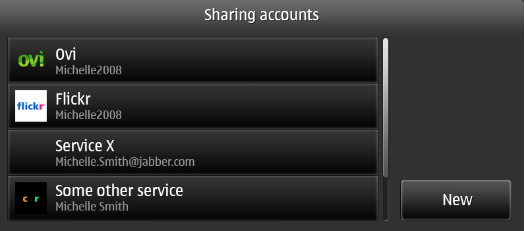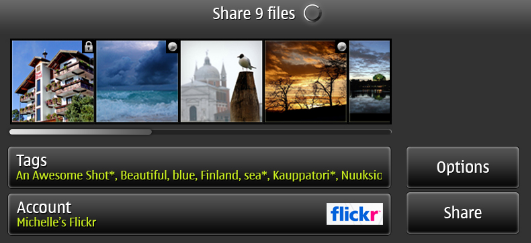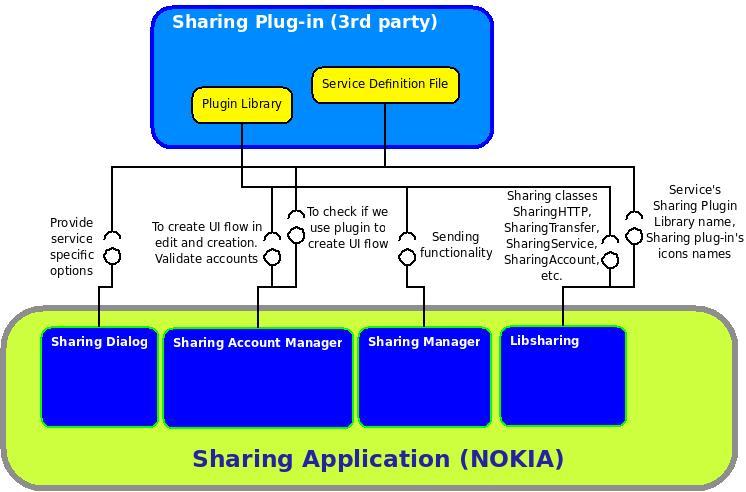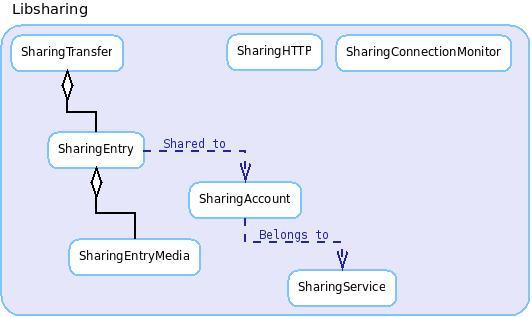Documentation/Maemo 5 Developer Guide/Using Data Sharing/Sharing Plug-in
Contents |
Sharing Plug-in Creation
Maemo 5 introduces a new library for handling Sharing related information and services. This chapter will walk you through the process of creating a sharing plug-in using a template plug-in as an example. Basic knowledge of Debian development and working in a Scratchbox environment is needed in order to follow these guides.
The example plugin can be browsed via the Subversion web interface
Sharing API reference documentation is available in the libsharing-plugin-doc package, or on maemo.org.
Before starting to create your own plugin, it is a good idea to check the default services OVI and Flickr. From those you can see two different UI flows for creating a sharing account. In OVI the UI flow is pretty simple and clear, you just enter the user name and password and then validate the account. In Flickr the flow is more complex, as before validation the user must login to the Flickr website to get authentication and continue the validation after that.
Sharing account creation can be accessed from the ‘Settings’ application:
Settings -> Sharing accounts -> New -> Select service ...
Sharing User Interfaces
The Sharing application implements common UI functionality needed for sharing files, and abstracts away much of the other functionality required for a file-sharing application. Sharing Application service support can be extended by using Sharing Plug-ins. These plug-ins can be created by any 3rd party developer. The plug-ins should implement the Sharing plug-in API functions listed in the API reference and define some parameters in a service definition XML file.
Figure 1 below shows the Sharing accounts dialog opened from the Settings application. You can create a new Sharing account or edit an existing one from the Sharing dialog. If you install a custom Sharing plug-in, you can see the service it provides in the "Select service list" when creating a new Sharing account.
Figure 1: Sharing Accounts
Figure 2 shows the Sharing Dialog user interface that is used to share images to the selected account on some service. The images displayed can come for example from the Photos application or from the device camera. You can choose the account created for your service from the "Account" combo box which holds all existing Sharing accounts.
Figure 2: Sharing Dialog User Interface
Getting Familiar With Target Service API
Many web services provide APIs that are available for 3rd party developers. In this tutorial, we focus on services that provide APIs for image and video uploads. It is possible to give the title, description and tags for the images using the common service API. Sharing supports image scaling and metadata filtering as common options for any service. Sharing plug-ins can have service specific options, like privacy. These settings can be accessed through the Options dialog (as shown in Figure 2.)
Adding Your Dummy Plugin To The Sharing Menus
As a prerequisite, you will need a working Maemo 5 SDK to continue further. We will first install the Sharing plug-in template:
- Obtain the template source code from the Maemo examples repository. It contains a good template file structure for a Sharing plug-in. The source code can be checked out with the command:
svn checkout https://vcs.maemo.org/svn/maemoexamples/trunk/data-sharing-plugin/
- Build a Debian package from the folder using the command:
./autogen.sh; dpkg-buildpackage -rfakeroot -d
- Install the built package to your Scratchbox environment or to the device if it was built with the ARM target.
- The template dummy service should be now visible in the Sharing application when creating new accounts.
Editing The Template Plug-in
In this section, we peek under the hood by opening the files in the template plug-in and get familiar with the Sharing classes that are used in the Sharing plug-in API.
Sharing Internals
Figure 3 shows the general overview of how a Sharing plug-in connects to the Sharing application using the Sharing plug-in API. The basic plug-in components are the service definition file and the plug-in library. The Sharing Application dialog is used to create SharingEntries that are shared by SharingManager. Sharing Account Manager implements the Sharing Accounts. Libsharing is a library for all common Sharing functionality.
Figure 3: Sharing Plugin API
Figure 4 shows the common Sharing classes found in libsharing that you would use when creating the plug-in.
SharingTransfer is the object that contains the data of a sharing task (a SharingEntry), including the overall status of the transfer process for a set of shared files.
SharingEntry contains the SharingEntryMedia, which are the individual files to be shared. It also knows the SharingAccount that is the target of sharing.
SharingAccount contains the username and password along with other parameters that you have to save for your service's account. It also has the information about SharingService which is registered to the SharingAccount.
Figure 4: Libsharing classes
To see the sharing classes in more detail you can browse to the Sharing plug-in example
Service XML File
The service definition file, located in the example at data/template.service.xml.in, is the starting point for plug-in loading. It defines the library that implements the Sharing plug-in API functions, the sign-up URL for new account creation with a web browser, the service name, icon file names and some basic information about the plug-in.
<?xml version="1.0" encoding="UTF-8"?>
<service plugin="libtemplate.so" provider="Me">
<accounts plugInSetup="0" plugInEdit="0">
<signup>www.maemo.org</signup>
<password maxlen="32"/>
</accounts>
<ui>
<name>Template</name>
<icon type="post">@servicesdir@/template-post.png</icon>
<icon type="setup">@servicesdir@/template-setup.png</icon>
<options>
<option id="privacy" type="enumeration" default="private">
<caption domain="osso-sharing-ui" key="share_bd_options_privacy"/>
<value id="private" domain="osso-sharing-ui" key="share_fi_options_privacy_private"/>
<value id="public" domain="osso-sharing-ui" key="share_fi_options_privacy_public"/>
</option>
</option>
</ui>
</service>
File 1: Example service definition XML file
The root of the service XML file name "template.service.xml.in", excluding any extensions , "template" in this case, defines the id of the plugin. The "plugin" value in the service definition defines the library that implements the Sharing plug-in API. In this example file the library is libtemplate.so. "Provider" is the developer name, nick, etc. In "accounts", you define the plug-in account setup and edit flows described more in detail in the coming sections. Signup is the URL that is opened in the browser when a new account is created for a service.
Account Setup User Interface Flow
Sharing accounts can either create a default UI flow where "username" and "password" parameters are set for the account in a standard dialog, or an optional custom flow. In File 1, the "accounts" tag has a parameter "plugInSetup". If it is set to "1", Sharing Accounts will call the Sharing plug-in API function "sharing_plugin_interface_account_setup" to create UI flow. The example in File 1 will use the default flow. You can see the difference between UI flows when creating a Flickr and an Ovi account. Ovi uses the default flow and Flickr uses its own UI flow.
SharingPluginInterfaceAccountSetupResult sharing_plugin_interface_account_setup (GtkWindow* parent, SharingService* service, SharingAccount** worked_on, osso_context_t* osso)
If you decide to create your own account setup flow, please try to keep the same UI look as in other Sharing dialogs.
Account Validation
Account validation is recommended so that errors due to incorrect login details are reduced. It is possible to use the dummy function of the template plug-in, but for a better user experience this function should be implemented so that Sharing Account information is validated against the service when a new account is created, not when a Sharing request is initiated.
The next function is called after the "sharing_plugin_interface_account_setup" call ends, or when the default account setup flow is complete (when the "Validate" button is pressed).
SharingPluginInterfaceAccountValidateResult sharing_plugin_interface_account_validate (SharingAccount* account, ConIcConnection* con, gboolean *cont, gboolean* dead_mans_switch)
In the last phase of account creation, the account must be validated. Sharing plug-in API sharing_plugin_interface_test_account is the function called in the validation phase of the account creation flow. Usually web services have a phase in account creation where you have input the needed information from your account, and only then do you get the actual credentials to upload images if your account information is valid. This is the phase that is implemented in the Sharing plug-in API function.
Account Editing User Interface Flow
Sharing Accounts support here too either default flow where “username” and “password” parameters are edited or optional custom edit UI flow. The wanted flow can be set by setting the parameter "plugInEdit" from the service definition file either to "0" or to "1" where "0" means the default flow and "1" plug-in flow.
The default flow can be used when you need only username and password to get needed information for sending. The plug-in flow is used when you need more than this or customised account validation flow. You can see the difference between UI flows here too when editing Flickr and Ovi accounts.
Next function must be implemented only when plug-in account setup is used (when "plugInSetup" is set to "1"):
SharingPluginInterfaceEditAccountResult sharing_plugin_interface_edit_account (GtkWindow* parent, SharingAccount* account, ConIcConnection* con, gboolean* dead_mans_switch)
Sending Functionality
SharingPluginInterfaceSendResult sharing_plugin_interface_send (SharingTransfer* transfer, ConIcConnection* con, gboolean* dead_mans_switch)
After pressing the 'Share' button in the Sharing dialog (Figure 2.), the data is put into the Sharing outbox (can be seen under /home/user/MyDocs/.sharing/outbox/). The Sharing manager process is started and an icon is added to the status menu to process the new Sharing Entry. SharingHTTP provides an API to create common HTTP requests. In order to create a better user experience, the following points should be implemented after you get the basic functionality working in your plug-in:
- Set the progress of the transfer with sharing_transfer_set_progress, which accepts a gdouble argument of between 0 and 1, to estimate the current or total transfer time.
- Mark each SharingEntryMedia (file) as sent with sharing_entry_media_set_sent when file sending is complete. Check the sent value with sharing_entry_media_get_sent to prevent sending the same file multiple times, for example in reboot scenarios.
- Poll the cancel flag from time to time, for example in the libcurl or SharingHTTP progress function to end transferring when needed. Use sharing_transfer_continue to get the continue flag bit.
- If you are using libcurl instead of SharingHTTP, please listen to conic events to disconnect transfer when no connection available. It returns with 'no connection' return value in this case.
Next some example source for common tasks found in usual sending functionality:
Example sending loop
When you process SharingEntryMedia from the SharingEntry you propably end up with a loop where you iterate over the list of SharingEntryMedia. Here is a bare example, where some example lines commented out with "//".
for (GSList* p = sharing_entry_get_media (entry); p != NULL; p = g_slist_next(p)) {
SharingEntryMedia* media = p->data;
/* Process media */
if (!sharing_entry_media_get_sent (media)) {
/* Post media */
//guint result = my_send_task_post_function (my_send_task, media);
/* Process post result */
if (result == 0 /* EXAMPLE: MY_SEND_RESULT_SUCCESS */) {
/* If success mark media as sent */
sharing_entry_media_set_sent (media, TRUE);
/* And mark process to your internal data structure */
//my_send_task->upload_done += sharing_entry_media_get_size (media);
} else {
/* We have sent the file in last sharing-manager call */
//my_send_task->upload_done += sharing_entry_media_get_size (media);
}
}
}
Example tags string
Usually, services provide API for adding tags to images. Here is example source code to create a string containing tag information, with ", " string used as a separator. If the service supports also geotagging you could develop this source further by checking the tag type also.
static gchar* create_tags_str (const GSList* tags)
{
gchar* ret = NULL;
for (const GSList* p = tags; p != NULL; p = g_slist_next (p)) {
SharingTag* tag = (SharingTag*)(p->data);
const gchar* tmp = sharing_tag_get_word (tag);
if (tmp != NULL) {
gchar* new_ret = NULL;
if (ret != NULL) {
new_ret = g_strdup_printf ("%s, %s", ret, tmp);
g_free (ret); /* old return is freed */
} else {
new_ret = g_strdup (tmp);
}
ret = new_ret;
}
}
return ret;
}
gchar* tags = create_tags_str (sharing_entry_media_get_tags (media));
SharingHTTP example
SharingHTTP is intended for HTTP transfers. It is probably easier to use this than libcurl and libconic directly in most cases. Give it a try, at least if you are not familiar with libcurl!
SharingHTTP * http = sharing_http_new (); SharingHTTPRunResponse res; res = sharing_http_run (http, "http://example.com/post"); if (res == SHARING_HTTP_RUNRES_SUCCESS) { g_print ("Got response (%d): %s\n", sharing_http_get_res_code (http), sharing_http_get_res_body (http, NULL)); } else { g_printerr ("Couldn't get stuff from service\n"); } sharing_http_unref (http);
Uninstallation
Libsharing provides sharing-account-remover binary that can be used to clean Sharing Accounts created for your plug-in. This binary is run by the Debian package's prerm script. Prerm scripts are run just before the package is uninstalled. Change the plug-in id from sharingplugintemplate to match your plug-in id in the script. Your plug-in's id is the service definitions files prefix. For template.service.xml, the prefix is "template".
Example prerm script:
#!/bin/sh # You can use sharing-account-remover to remove the accounts at plugin # uninstallation if [ "$1" = "remove" ]; then /usr/bin/sharing-account-remover template fi
Testing your plugin
After setting up your scratchbox environment you can start using and testing your own plugin.
Sharing framework consists following packages:
libsharing-plugin-dev libsharing0 sharing-manager sharing-account-manager sharing-dialog sharing-service-ovi sharing-service-flickr
All the needed packages should be installed along with nokia-binaries.
Important: When testing inside scratchbox remember to start the signond daemon after the desktop is started. Signond is used for storing the account information and it's needed in order to get Sharing framework working properly
[sbox] > signond &
Also remember to install the debian .deb package build from your sources.
Creating sharing account is started from setting.
settings -> Sharing accounts -> New
Select your service and create new account. After one account is created you can use ImageViewer for sharing images and MediaPlayer for sharing video files.
Sharing your plugin with others
Maemo Extras repository is the best place for your plug-in if you want to get users for it. More information on how you can upload packages to Extras repository can be found [here].
Before uploading plugin to public repositories make sure you have updated the debian configuration files to match your information under ./debian folder.
Also make sure that the section is set to one of the valid sections listed in the packaging guide. For data sharing, use "user/multimedia". This way the package will be installable by application manager. Below example version of debian control file.
Source: sharing-plugin-template Section: user/multimedia Priority: optional Maintainer: Maemo Team <xxxx@maemo.org> Build-Depends: debhelper (>= 5.0.0), libgtk2.0-dev, libglib2.0-dev, libconic0-dev, libosso-dev, libsharing-plugin-dev Standards-Version: 3.8.0




